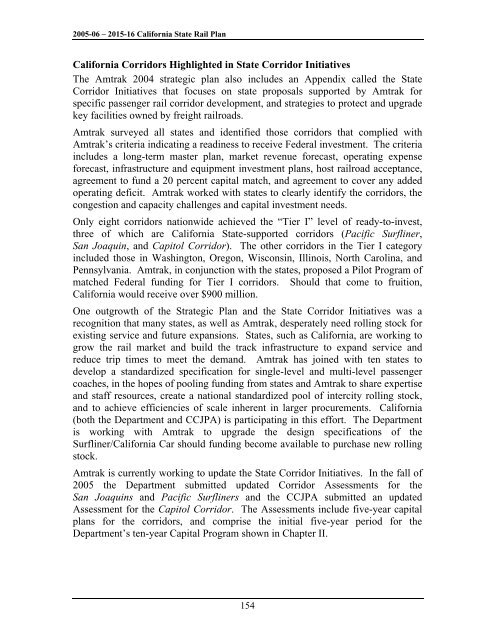California State Rail Plan 2005-06 to 2015-16
California State Rail Plan 2005-06 to 2015-16
California State Rail Plan 2005-06 to 2015-16
You also want an ePaper? Increase the reach of your titles
YUMPU automatically turns print PDFs into web optimized ePapers that Google loves.
<strong>2005</strong>-<strong>06</strong> – <strong>2015</strong>-<strong>16</strong> <strong>California</strong> <strong>State</strong> <strong>Rail</strong> <strong>Plan</strong><br />
<strong>California</strong> Corridors Highlighted in <strong>State</strong> Corridor Initiatives<br />
The Amtrak 2004 strategic plan also includes an Appendix called the <strong>State</strong><br />
Corridor Initiatives that focuses on state proposals supported by Amtrak for<br />
specific passenger rail corridor development, and strategies <strong>to</strong> protect and upgrade<br />
key facilities owned by freight railroads.<br />
Amtrak surveyed all states and identified those corridors that complied with<br />
Amtrak’s criteria indicating a readiness <strong>to</strong> receive Federal investment. The criteria<br />
includes a long-term master plan, market revenue forecast, operating expense<br />
forecast, infrastructure and equipment investment plans, host railroad acceptance,<br />
agreement <strong>to</strong> fund a 20 percent capital match, and agreement <strong>to</strong> cover any added<br />
operating deficit. Amtrak worked with states <strong>to</strong> clearly identify the corridors, the<br />
congestion and capacity challenges and capital investment needs.<br />
Only eight corridors nationwide achieved the “Tier I” level of ready-<strong>to</strong>-invest,<br />
three of which are <strong>California</strong> <strong>State</strong>-supported corridors (Pacific Surfliner,<br />
San Joaquin, and Capi<strong>to</strong>l Corridor). The other corridors in the Tier I category<br />
included those in Washing<strong>to</strong>n, Oregon, Wisconsin, Illinois, North Carolina, and<br />
Pennsylvania. Amtrak, in conjunction with the states, proposed a Pilot Program of<br />
matched Federal funding for Tier I corridors. Should that come <strong>to</strong> fruition,<br />
<strong>California</strong> would receive over $900 million.<br />
One outgrowth of the Strategic <strong>Plan</strong> and the <strong>State</strong> Corridor Initiatives was a<br />
recognition that many states, as well as Amtrak, desperately need rolling s<strong>to</strong>ck for<br />
existing service and future expansions. <strong>State</strong>s, such as <strong>California</strong>, are working <strong>to</strong><br />
grow the rail market and build the track infrastructure <strong>to</strong> expand service and<br />
reduce trip times <strong>to</strong> meet the demand. Amtrak has joined with ten states <strong>to</strong><br />
develop a standardized specification for single-level and multi-level passenger<br />
coaches, in the hopes of pooling funding from states and Amtrak <strong>to</strong> share expertise<br />
and staff resources, create a national standardized pool of intercity rolling s<strong>to</strong>ck,<br />
and <strong>to</strong> achieve efficiencies of scale inherent in larger procurements. <strong>California</strong><br />
(both the Department and CCJPA) is participating in this effort. The Department<br />
is working with Amtrak <strong>to</strong> upgrade the design specifications of the<br />
Surfliner/<strong>California</strong> Car should funding become available <strong>to</strong> purchase new rolling<br />
s<strong>to</strong>ck.<br />
Amtrak is currently working <strong>to</strong> update the <strong>State</strong> Corridor Initiatives. In the fall of<br />
<strong>2005</strong> the Department submitted updated Corridor Assessments for the<br />
San Joaquins and Pacific Surfliners and the CCJPA submitted an updated<br />
Assessment for the Capi<strong>to</strong>l Corridor. The Assessments include five-year capital<br />
plans for the corridors, and comprise the initial five-year period for the<br />
Department’s ten-year Capital Program shown in Chapter II.<br />
154













